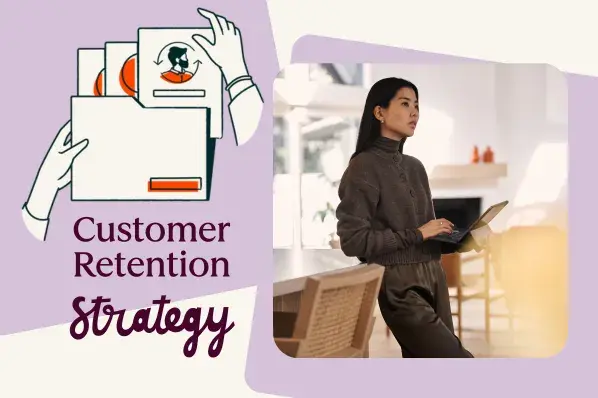Let’s look at a few possible reasons you might be losing customers.
9 Reasons You’re Losing Customers

1. Poor Customer Service
Your organization’s customer service starts from the moment a customer contacts a representative of your company. And the number one reason you might be losing customers is poor customer service.
The best sales representatives understand customer service is more than closing a deal.
Excellent customer service involves building relationships with clients and connecting with them personally. 82% of sales reps agree this is the best part of the job, too.
Once your sales reps establish a genuine connection, they can better understand and serve their clients, offering only the best care and service.
Pro tip: Put yourself in your customers’ shoes and ask yourself: “Would I be satisfied with the level of customer service that I’m receiving from my representatives?” If the answer is “no” or even a meager “maybe,” it’s time to consider how you can boost your customer service game.
2. Confusing Pricing
A second reason you might lose customers is inconsistent pricing. You know the worth of your product and the value it provides for your customers. However, if you do not price it correctly and clearly define your offerings, this can cause confusion for customers. It gives them a reason to walk away from your business.
The best sales reps know to look at their products or services from a customer’s perspective. From a customer standpoint, it makes the most sense to look at options from lowest to highest when it comes to pricing, which is why 84% of SaaS companies price their products from lowest to highest.
Tiered pricing and subscriptions are great pricing models. Still, if you’re not clear on what you are offering, your tiers heavily overlap, or you present the highest option first, you’re potentially misrepresenting the value your product or service offers.
Pro tip: Consider reconsidering your pricing and accurately defining what you’re offering customers to eliminate confusion.
3. Lack of Training
Think like a customer for a second. Have you ever been in a situation where you were ready to make a purchase, but it was clear the sales professional did not understand the product, how it could benefit you, or the art of the sale? For a customer, nothing is worse than dealing with a sales professional who lacks the necessary training.
As a business owner or department manager, you know what it takes to help your sales representatives excel in their jobs: training and sales enablement.
Over half of sales professionals rely on sales enablement content daily. And 79% of those sales pros agree that sales enablement is vital to making a sale. With the proper training and enablement, your sales representatives can provide the utmost customer service for your clients.
Pro tip: Review your sales enablement documents and training plan. This can be the difference between losing clients and retaining them.
4. Over-Promising and Under-Delivering
You probably know the phrase “Honesty is the best policy.” The same concept applies to sales, meaning your sales reps should never hype up a product or service so much that it fails to deliver what is promised.
Over-promising and under-delivering fall flat when it comes to customer satisfaction, which is likely why customers walk away from a brand. The best sales reps understand that a customer’s trust in a brand must be protected. Once the trust is gone, it is hard to gain it back.
Pro tip: When training your sales reps, ensure they understand the key aspects of your product or service to help them better convey the product or service’s promise.
5. Underrepresenting Your Product or Service
Just like overpromising a product or service’s value, underrepresenting it can cause a loss of customers. With the internet at their fingertips, 96% of customersresearch a product or service before speaking with a sales professional.
This means your customer likely already has a good understanding of what your product or service offers. What they might need help understanding, though, is how the product or service can benefit them directly.
There is a reason great sales professionals spend time connecting with their customers. This time is spent understanding their customers’ specific pain points. Because customers have already researched the product or service, a salesperson’s time with a customer is better spent explaining how the product or service can benefit them than explaining the product’s features.
Pro tip: Encourage your sales teams to talk with customers about their pain points. This will illuminate new ways your product or service can help them.
6. Slow Response Times
With 65% of revenue coming from existing customers, an organization should consider ways to maintain those customer relationships. Putting customers on hold or slowly responding to their queries and emails is not a suitable retention method and can be why your company is losing customers.
It’s no secret that sales professionals are busy people who have more on their plate than just sales. Data shows only two hours of a sales rep’s day is spent on sales, which is why more and more star sales reps are turning to AI tools to help them automate specific time-consuming tasks.
With the time saved with AI automation, those sales reps are free for other things, like responding to customers and helping solve issues.
Pro tip: Use AI tools like HubSpot AI to automate tasks and enable your reps to work on other customer-facing tasks.
7. Lack of Personalization
Do you know the warm and fuzzy feeling you get when someone says your name? That’s the feeling you should give your customers to let them know you and your team care.
Impersonal interactions between a customer and sales rep often feel cold and leave the customer feeling as if they are not important. For those customers, it’s easy to leave one brand behind for another who has taken the time to personalize the customer experience.
Personalizing a customer’s experience with your brand doesn’t have to be complicated. 66% of sales professionals use AI tools to help personalize every step of the sales process for their customers.
Good sales professionals also know that customers love to hear their name and will actively say it during conversations with clients.
Pro tip: The more your sales reps can personalize the sales process, the better.
8. Resistance to Change
With the introduction of AI, there is no denying that industries are constantly changing. And that includes the sales industry, too. These rapid changes demand sales professionals be flexible and open to change, even if it requires throwing out what they’ve always done to close a deal.
Being resistant to change means you are closing a door to potential sales and likely not meeting the needs of your current customer base. Good sales reps understand that to retain customers successfully, they must adapt to the times and keep up with trends.
Pro tip: Keep an eye on your and your customers’ industry to stay up-to-date with new trends.
9. Being a Product, Not a Partner
Are your sales reps selling a product or a partnership? The immediate answer might be “a product” because that’s precisely what your organization sells. However, positioning your brand as just a product might be where you lose customers.
Customers don’t want just another product. They want to be confident in their purchase and know that if they need help, your brand is in their corner. The best sales reps understand they are not just selling a product or service.
Instead, they are forging a partnership with the client and your brand. And the most successful sales professionals use collaborative words, like “we” and “us,” to help promote and maintain partnerships with the customer.
Pro tip: Train your sales professionals to use collaborative words, like “we” and “us,” to help promote partnership.
How to Turn Your Strategy Around
If your company is losing customers, don’t fret. Although losing a customer is not fun, use it as a learning opportunity to improve your business operations. There are several things you can do to bring your customers back and increase customer retention.
Use these tips from experienced customer service professionals to create a plan to regain your clients.
1. Analyze customer behavior.
If you notice that you’re losing customers, it can be difficult to pinpoint exactly why that is the case. Sure, there are reasons like those listed above, but you won’t know until you ask your customers.
As a customer service coordinator, Jackie Ryan suggests “conducting customer feedback surveys and interviews and analyzing customer behavior to better understand why they are leaving.”
Asking for meaningful feedback through a survey is a great way to gather customer retention metrics to help you better understand a customer’s decision to stay with or leave your brand.
Survey responses can highlight areas you and your team can improve to help mitigate customer loss and improve retention. Make sure to ask appropriate questions and provide your clients with the opportunity for open-ended discussions.
2. Propose solutions and offer support.
Customers need to know they’re not just another number for your organization’s bottom line. However, they’ll feel like “another number” if your team does not offer personalized support and solutions when they experience an issue.
Gene Caballero, co-founder of GreenPal, says, “It’s not just about fixing the issue, but also offering support and reassurance. In my experience, personalized solutions greatly enhance customer satisfaction.”
If you’re able to see the breakdown in a customer relationship before it completely crumbles, you and your team should propose personalized solutions to fix the issue and offer your customer support to bring them back to your brand.
3. Quickly respond to customers.
One of the reasons you might lose customers is a delayed response time. An obvious strategy to fix this issue is to make it a priority to respond to customers quickly.
Joel Wolfe, president and founder of HiredSupport.com, says, “Customers value being heard, and part of being heard is being heard right now. And not being heard tomorrow or two days from when the initial complaint was made. That further deteriorates the customer relationship you’re trying to salvage.”
The longer you and your team wait to respond to their queries, the higher the chance a customer will be unsatisfied with your company.
4. Ensure your team is on the same page.
Remember how we mentioned that overpromising and underrepresenting your product or service are two reasons you might lose customers? There is a way to mitigate those issues to keep your clients with your company, and that is to ensure that every member of your company, whether that’s customer success or your receptionists, is on the same page.
Mike Bonventre, an entrepreneur and business consultant, suggests that customers leave a company because “the employees that are doing the job are not in sync with sales.”
In other words, your customers receive conflicting information from one department to another. This leaves the door open for overpromising or underrepresenting your product or service.
You can mitigate this by training your departments on the features and benefits of your product or service so that only accurate information is passed on to your clients.
5. Treat all customers as a priority.
This goes without saying, but your customers are your most important priority. Without customers, your business is sure to go under. However, one way to retain your customer base is to make your customers feel like they are your and your team’s top priorities.
Mike Bonventre says, “Forget about the money. Every minute you are thinking about money, you’re not thinking about providing customer service. Remember your priority.”
Mike’s suggestion might seem to go against the grain, but when your customers are your first priority, you can be sure you’re providing them with the best customer service possible. Customers who are satisfied with your customer service are likely to stay with your business.
Plus, happy customers are also more likely to tell others about your brand.
It’s important to take the time to understand why your customers are leaving and what you can do as a team to bring them back. To learn more about customer retention and strategies you can implement today, check out our free library of customer retention resources.
Implementing a Retention Strategy to Stop Churn
Losing customers can feel as if it’s the end for your business. While losing clients certainty impacts your revenue, it doesn’t have to be the end for your company. With the right strategy in place, you can recover from it.
Customer Retention
.png?width=112&height=112&name=Image%20Hackathon%20%E2%80%93%20Vertical%20(67).png)

.png)

-2.png)
![7 Customer Acquisition Challenges You Might Face This Year [New Data]](https://53.fs1.hubspotusercontent-na1.net/hubfs/53/customer%20acquisition%20%20(1).webp)




![7 Secrets for Getting Repeat Customers That Stick Around [Consumer Data]](https://53.fs1.hubspotusercontent-na1.net/hubfs/53/repeat-customers.jpg)


